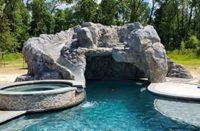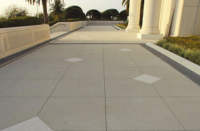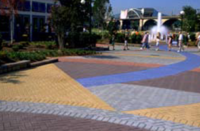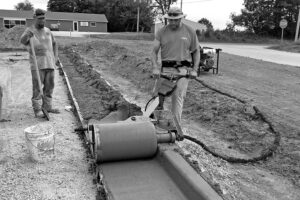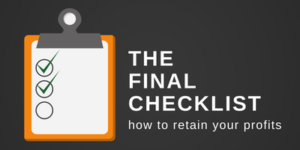Decorative curbing is giving entrepreneurs across the country a creative edge in the competitive concrete market. For many it is a stand-alone business; for others a lucrative add-on.
“Concrete curbing is one of the fastest growing segments of the landscape industry,” observes Jeremy Garrett, president of Tygar Manufacturing Inc. He’s not alone in this assessment.
Larry Rose, president of Curbmate Corp., and Lane McKinnon, director of manufacturing at Tool Engineering and Manufacturing (maker of Curb-King), also report the majority of decorative curbing is used in landscape applications.
 Residential market growing by leaps and bounds
Residential market growing by leaps and bounds
The most popular curb style among homeowners is the mower edge.
“It has the lower edge set at the same height as the firm sod for lawn-mowing applications,” Rose explains. “It then curves over and up so that the back side is higher, allowing for raised flower beds. In the early days we emphasized the beauty of this style by saying that it was like putting a picture frame around your landscaping.”
But another style is gaining in popularity, too. “The slant style has become very popular because it likewise has a lower side against the grass and a higher side for raised flower beds,” Rose says. But instead of curving up to the back side, this curbing has a straight slant, allowing for imprints and impressions that look like stone or slate or brick.
Style and profile preferences naturally vary from region to region of the country. McKinnon reports that in Southern California, a 5-inch profile with rounded edges is popular, while the most popular preference in the Northwest is exposed aggregate. In Las Vegas, customers favor a very narrow 4-inch by 4-inch profile.
 Preferences for a smooth or stamped finish seem to mirror architectural styles. “We find that nationwide, the stamped curb is more popular,” Garrett says. “In the western United States and Florida there are many smooth-finished or stucco homes. In these areas contractors will use more smooth-finished colored curbs.” Because stamp designs and color choices are virtually endless, a contractor can pretty much make the curbing match the exterior décor of a customer’s home —brick, stone, wood, whatever.
Preferences for a smooth or stamped finish seem to mirror architectural styles. “We find that nationwide, the stamped curb is more popular,” Garrett says. “In the western United States and Florida there are many smooth-finished or stucco homes. In these areas contractors will use more smooth-finished colored curbs.” Because stamp designs and color choices are virtually endless, a contractor can pretty much make the curbing match the exterior décor of a customer’s home —brick, stone, wood, whatever.
What you need to get started
Robert Parrish, CEO of Decorative Curbmaking Machines Inc., lays out a list of what you need to get a curbing business going: an extrusion machine, mixer, sod cutter, plate compactor and trailer. “It normally takes two people to get a job done,” he says, “but three to four people will cut the installation time down.”
As with most things, speed of installation directly affects the profit margin, and installation time is dependent on the scope and difficulty of the project, site preparation, and the efficiency of the crew. “An owner is generally part of the crew,” Garrett says. “This will help your cash flow and cost of labor tremendously.”
 Leon Burch, owner and president of Concrete Crafters, one of the leading commercial curbing firms in the country, emphasizes the importance of having both a good business plan and a good marketing plan. “I worked for years in the residential market — it’s tough. Customers sometimes have unrealistic expectations.” Unfortunately, he adds, some homeowners go with the cheapest price, though it is likely not the best work.
Leon Burch, owner and president of Concrete Crafters, one of the leading commercial curbing firms in the country, emphasizes the importance of having both a good business plan and a good marketing plan. “I worked for years in the residential market — it’s tough. Customers sometimes have unrealistic expectations.” Unfortunately, he adds, some homeowners go with the cheapest price, though it is likely not the best work.
Garrett estimates, “Depending on the region, cost of materials can be from 30 cents to 50 cents a foot for colored curb, and 90 cents to $1.10 a foot for stamped curb. Again, depending on region, contractors are charging anywhere from $3 a foot to $5 a foot for colored curb and $6 a foot to $10 a foot for stamped curb.”
Equipment is a major upfront cost. Many in the industry emphatically stress the importance of making good equipment choices.
“A word to the wise about purchasing curbing equipment: Cheap is not always the best way to go,” says Parrish. “If you are serious about getting into the business, weigh your options carefully — it can be the difference between your success or total failure. Make sure you compare apples with apples.”
 Burch observes, “It’s really a hostile environment. Look for quality equipment. It has to deal with moisture, dust, dirt, grit and grime. Check the quality of the power plant on the machinery you get. Does it have a reputable engine? Look at the bearings. Really shop it. Look at the quality of the trailer, the mixer and the whole package.”
Burch observes, “It’s really a hostile environment. Look for quality equipment. It has to deal with moisture, dust, dirt, grit and grime. Check the quality of the power plant on the machinery you get. Does it have a reputable engine? Look at the bearings. Really shop it. Look at the quality of the trailer, the mixer and the whole package.”
Extrusion machine technologies, including ram or plunger compaction, single- or double-auger, vary from manufacturer to manufacturer. Consider the advantages and disadvantages of the different technologies and research the durability track record of different product models. It is not uncommon to see conflicting information, so do your homework. Test-drive the machines. Get contractor references from equipment manufacturers and talk to experienced contractors.
Tools and techniques for applying textures and finishes to curbing are similar to those used for flatwork. However, with many curbing profiles it is faster to apply an imprint using an imprint roller. Many kinds are available. Again, shop around for the tools you’ll use.
Custom designs and lighted curbing
The demand for custom curb designs is growing, but remains a small segment of the market. This includes custom shapes as well as custom stamp patterns. As Garrett observes, “They do take a little time to catch on, but they end up being a standard part of each contractor’s curbing operation.”
Homeowners across the board are using more and more accent lighting in their landscapes, but that does not necessarily translate to jumps in demand for lighted landscape curbing. “We see lighted curbing growing, but slowly — it’s pricey,” McKinnon says. He says lighted curbing can add $7 per foot to the retail price of plain curbing.
There are some challenges to installing lighted curbing, too.
Typically a rope or piece of foam is embedded in the mortar or concrete mix as the curbing is extruded. When the curb sets up, the rope or foam is removed and rope lighting inserted. That may seem pretty straightforward, but McKinnon says it can get tricky sometimes with inside curves, where the rope may want to pull itself out.
 You also need an electrical hookup. “The lighting is equipped with an outdoor-rated plug that can be plugged into an outdoor GFI outlet. You can also hook a timer into the lights to regulate when the lights will come on and go off,” Garrett says.
You also need an electrical hookup. “The lighting is equipped with an outdoor-rated plug that can be plugged into an outdoor GFI outlet. You can also hook a timer into the lights to regulate when the lights will come on and go off,” Garrett says.
In all cases, Parrish says, “Make sure you have UL approval on all your light products, have EFI breakers, and meet all electrical codes, or your customers may end up owning your company as well as maxing out your liability policy!” And, he cautions, “‘Weed eaters,’ playful animals, shovels and rakes can destroy plastic rope lighting. Also, UV rays will make the plastic brittle in time. Plus lights do burn out.”
Training is important
If decorative curbing is a business that appeals to you, be sure to get some quality hands-on training. Look for specialized training that gets you over the learning curve, beyond simple equipment operation.
In addition to curbing installation training, some equipment manufacturers offer expanded training that helps a new business owner get a handle on their business operations and marketing and sales activities.
Marketing yourself
To drum up business in the residential marketplace, advertising is a must, but the type you use may vary depending on your market.
“If consumers don’t know about decorative curbing, you’ll need to educate them,” McKinnon explains.
In this situation, he says, a home-show booth is effective. “Have a machine running in the booth, extruding sand, so they can see how it works.”
Another effective method is to install decorative curbing in high-profile locations. “A corner home in a neighborhood is the best advertisement you can get,” Garrett says. “The curb will sell itself after potential customers can see it on the ground. The first few jobs may have to be at a reduced or discounted rate, but they will pay for themselves time and time again.”
Arrange with the homeowner to post signs during installation and a short time afterward. And distribute fliers and door hangers to neighbors.
Selling decorative curbing as an upgrade or landscape improvement is also effective.
Advertising in newspapers and the Yellow Pages is recommended in a mature market where decorative curbing is not new, though this kind of advertising can get costly.
Of course the best advertising, Parrish says, is word-of-mouth. But, he adds, “You better do a good job.”
The commercial market
Commercial curbing applications range from industrial applications, such as retaining curbs inside manufacturing plants, to retail applications, such as parking lot curbing, to commercial landscape projects. It is a much tougher market to get into than residential, but not impossible.
“Commercial curb is marketed by talking to contractors, developers, architects, landscapers and anyone in the commercial building field,” Garrett says. “Some curbing contractors have installed curbing on a spec or model home for free. This gets great exposure to the commercial market.”
McKinnon reports some decorative curbing contractors are successful in developing ongoing working relationships with landscaping firms. In this kind of business-to-business relationship, when a landscape contractor secures a project that includes curbing, he relies on his curbing contractor to handle that part of the installation.
